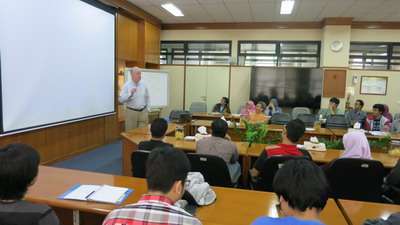 Dr. James C. Dennison delivered a guest lecture on the “Frequency Dependent Gain Model of the Operational Amplifier” at STEI ITB on 15 April 2016. The lecture was attended by several ITB Professors as well as the Electrical Engineering undergraduate students of EL3013 (Instrumentation Systems). His teaching approach addresses a pressing problem in engineering education; i.e. the ever widening gap between engineering students’ practical design ability when they graduate and the practical design skills that industry managers need or require to make their businesses competitive in today’s global marketplace.
Dr. James C. Dennison delivered a guest lecture on the “Frequency Dependent Gain Model of the Operational Amplifier” at STEI ITB on 15 April 2016. The lecture was attended by several ITB Professors as well as the Electrical Engineering undergraduate students of EL3013 (Instrumentation Systems). His teaching approach addresses a pressing problem in engineering education; i.e. the ever widening gap between engineering students’ practical design ability when they graduate and the practical design skills that industry managers need or require to make their businesses competitive in today’s global marketplace.
In his lecture, Professor Dennison demonstrated that designers must take the actual Op Amp specifications provided by device manufacturers into account. For example, the Op Amp gain magnitude (both open loop & closed loop) should no longer be modeled as fixed (as usually assumed in ideal academic designs), but instead as a frequency dependent device parameter. Using this approach, the results obtained at each engineering design stage would be more or less the same, i.e. the results of pen & paper analysis, computer simulation, and hardware testing would then be in close agreement. Specific system performance, when non-ideal Op-Amp specifications are incorporated, can then be reliably predicted and obtained. Using ideal op amp specifications instead does not always result in predictable or achievable system performance.
Jim Dennison has an extensive background both in industry and academia. Presently he is on temporary leave from his position of Full Professor of Engineering at McNeese State University (USA) and is serving as a Fulbright Senior Scholar in the Electrical Engineering Department of STEI ITB for the 2015/2016 academic year. Prior to his 20 years in academia, he was a product design engineer and project manager at IBM for 30 years. At ITB, Jim continues to develop teaching materials for practical system design that incorporate non-ideal Op-Amp specifications.
Contributor :Ir. Arief Syaichu Rohman, MEngSc, Ph.D

